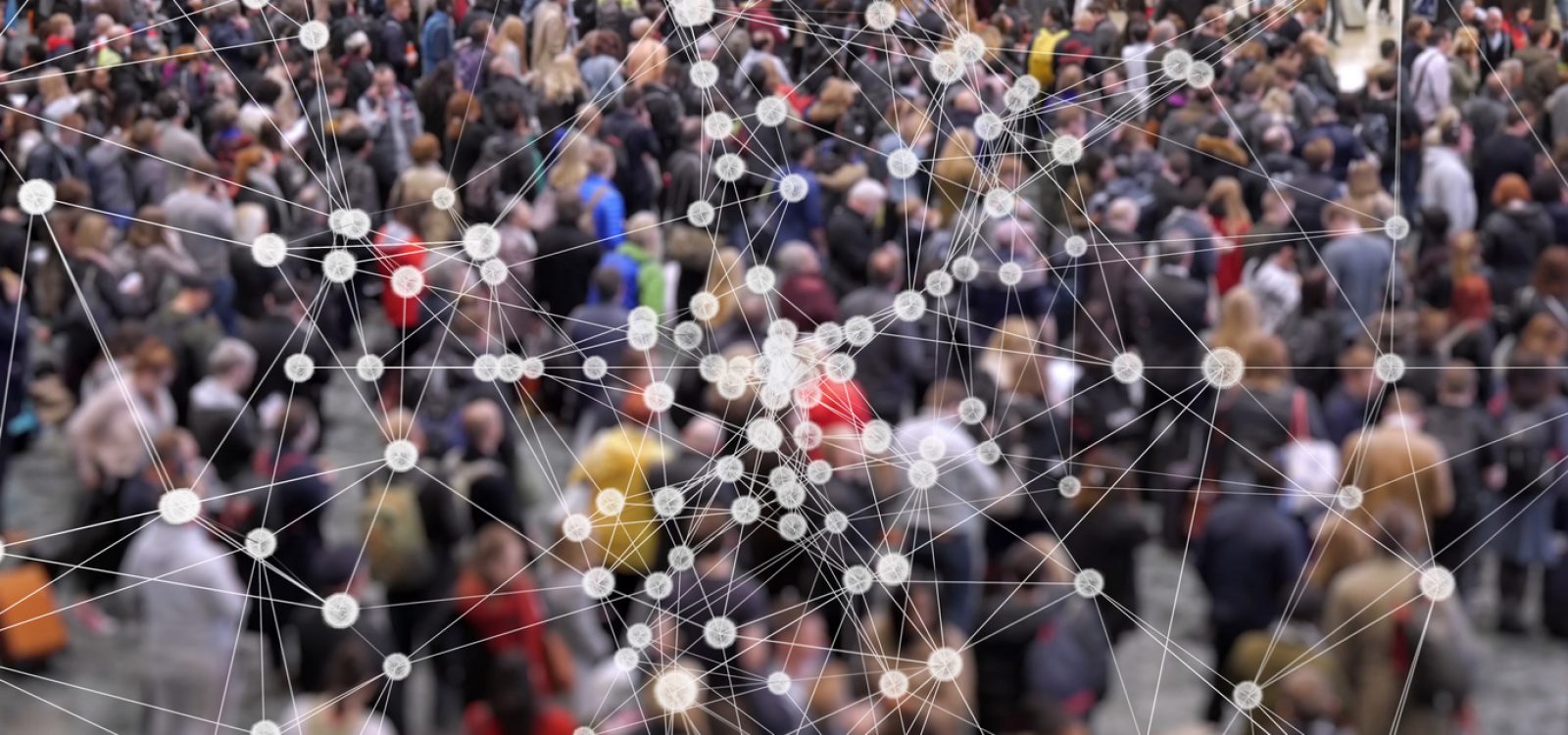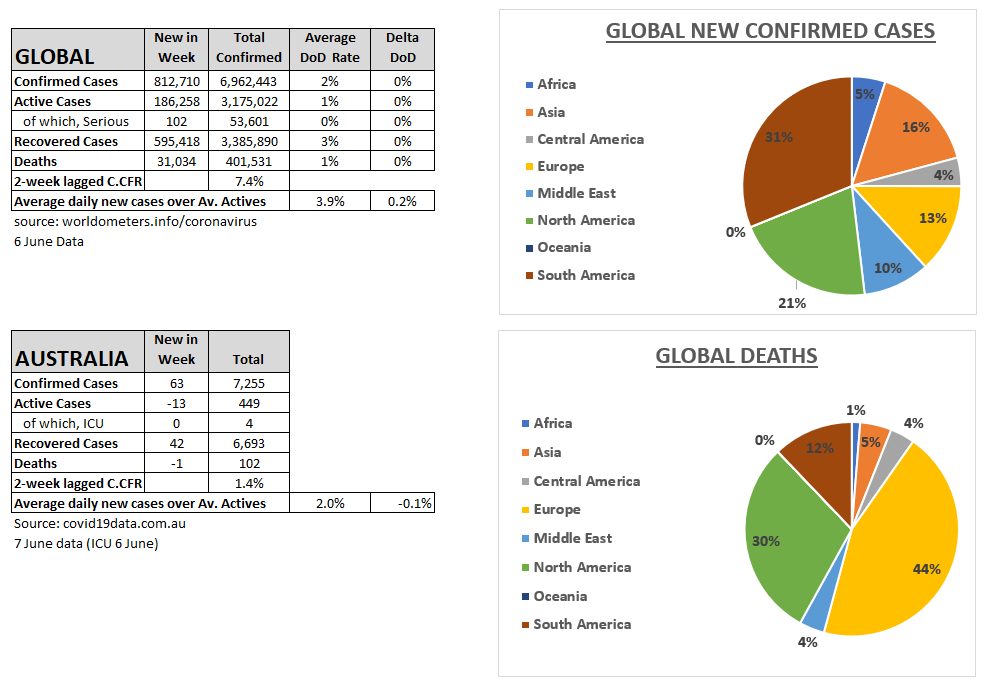
Covid-19 Blog
COVID-19 Monday Roundup 9 June 2020
This week’s roundup comes to you on Tuesday after yesterday’s public holiday across most of Australia. With one million new cases added to the global tally this week, New Zealand’s declaration of no active cases seems all the more remarkable. The WHO re-started clinical trials of hydroxychloroquine and changed its advice on wearing face masks, while in Australia, child care will be the first sector losing government support.

World Summary – 6 June
- Confirmed cases reached 7 million on Monday, with 2 million in the US, active cases passed 3 million and deaths reached 400,000.
- New cases grew 8% in the week, and new deaths grew 15%. With the exception of the USA, the locus of the pandemic has firmly moved away from its former hotspots.
- 14 (+2, Chile, Mexico ) countries have outbreaks of 100,000+ and a further 43 (+5, Bolivia, Armenia, Nigeria, Iraq, Algeria) countries have outbreaks of 10,000+. Of outbreaks over 10,000, Mexico’s is the fastest growing. Mexico, Iraq, South Africa, Chile, Iran, and Bahrain all had average daily new case rates of 10% or more.
- 14 countries reported over 10,000 new cases this week headed by Brazil, USA, India and Russia. These 14 countries account for 84% of the reported new cases.
- Central America Mainland and Southern Africa are the fastest growing regional outbreaks with growth rates of over 10%, dominated by Mexico and South Africa respectively. The South American outbreak reduced pace slightly, but the pace of the massive North American outbreak increased slightly.
- Total deaths and the C.CFR are dominated by USA, UK, Brazil, Italy, France, Spain and Mexico who account for 73% of deaths. The US accounts for 28% of deaths, but Brazil is now projected to have more deaths than the USA.
- On a positive note, New Zealand now has no known active cases of COVID-19, and lifted almost all internal restrictions on New Zealanders effective midnight last night. A pre-print publication estimates that after 2-3 weeks of no new cases, there’s a 95% chance this virus has been eliminated.
Australia Summary – 7 June
- More than two weeks have passed since Australia’s last confirmed COVID-19 death.
- Locally acquired new cases remain low. Only Victoria and Queensland had community transmission cases in the last week.
- Weekly new cases were again dominated by Victoria’s 36 (-13) new cases. NSW had 15 (+2) , WA had 7 (-18), Queensland had 2 (+0). SA, ACT, Tasmania and NT had no new cases. The NT and SA have no known active cases.
Key market updates
- To help more people access financial advice, ASIC has introduced temporary relief measures for financial advisers.
- The RBA left interest rates and current monetary policy settings unchanged again last Tuesday.
- The Government announced the “Homebuilder” program last week which aims to inject $680m into the construction sector
- Free childcare will end on 12 July, as will Jobkeeper payments for the childcare sector. An alternative funding model is being developed for the childcare sector.
- The superannuation industry is warning that fraudsters will again target the early release superannuation scheme unless the Federal Government urgently boosts protections. ASIC has released COVID-19 financial and money scam alerts.
- PwC Australia, Salesforce and Google have joined forces to create Project Spirit, a free online marketplace that helps Australian businesses come together to share capacity, skills and create opportunity.
- A wide range of Industry groups and consultancies have released reports on how Australia could restart the economy, including The Financial Services Council and PwC’s reports on the Australian tax system and financial services sectors.
New COVID-19 research this week
- Several weeks ago we reported on the significantly higher mortality for black and minority patients in the UK and US. This article hypothesises some reasons, including over-representation in low socio-economic groups, multi-family and multi-generational households leading to greater transmission, more health co-morbidities, and greater numbers in key worker roles, such as frontline health workers.
- A Lancet publication which found hydroxychloroquine increased the risk of death in those with COVID-19 has been retracted because Surgisphere, the company which collated hospital data for the study, would not release the data for independent third party review. The WHO has since re-started use of hydroxychloroquine in its Solidarity clinical trial.
- The WHO changed its advice on wearing face masks, saying governments should encourage the general public to wear fabric masks where there is widespread transmission and in areas where physical distancing is difficult, such as on public transport, in shops or in other confined or crowded environments. Those aged over-60 and with underlying health risks should wear medical masks in areas where there is community transmission. Many countries already mandate mask-wearing on public transport, the UK will do so from 15 June.
- A systematic review of published literature has found that physical distancing of 1 metre can reduce the risk of virus infection by up to 82%, face masks and respirators by up to 85%, and eye protection by up to 78%.
- The dispersion factor (k) is becoming as important as the transmission rate (R0). It measures the extent to which the virus clusters: a low k, means few people are responsible for the bulk of transmission. The k for COVID-19 is estimated at 0.1, meaning 80% of secondary transmissions come from 10% of people. Shouting, singing, Zumba and social butterflies are all implicated in this interesting article on superspreaders.
- Abattoirs have seen several outbreaks of COVID-19, in part because of higher humidity, lower temperatures and metal surfaces allow the virus to survive longer. Other factors identified in US research include difficulty for workers to physically distance, the demands of the work which make wearing face masks correctly difficult, and some sites struggling to adhere to heightened cleaning guidance. Socio-economic factors have also been critical. Low income workers felt pressured to work despite being ill, and language was a challenge – one site in the US had workers with 40 different primary languages.
- Modelling from the UK estimates the likely impact of different interventions, including school closures, physical distancing and lockdown through to December 2021, while data on excess deaths in the UK up to 22 May, is now available subdivided by age group.
New on the Actuaries Institute website this week
- Actuaries Digital article: How exposed is your occupation to COVID-19? by Benjamin Howe and Aman Pamnani
- Updated Pandemic Briefing: Scenario and Stress Testing
This work is licensed under a Creative Commons Attribution-NonCommercial-No Derivatives CC BY-NC-ND Version 4.0.
CPD: Actuaries Institute Members can claim two CPD points for every hour of reading articles on Actuaries Digital.






